Isoreticular synthesis of 2D MOFs with rotating aryl rings†
Abstract
A series of isoreticular two-dimensional metal–organic frameworks (MOFs) was synthesized with group 11 metals and semirigid ligands that bind in a syn conformation. The modular synthetic approach allows the pore to be expanded based on the aryl moiety in the center of the linker from 11.0 Å to 15.5 Å. When there is an axis of rotation, each aryl ring can act independently as a rotating gate as a function of guest molecules. For the two aryl ring system, all three states (open/open, open/closed, and closed/closed) are observed by single crystal X-ray diffraction (SCXRD). The guest dependent nature of the aryl rings makes this two-pillared topology a logical choice for breathing MOFs.

- This article is part of the themed collection: 2015 Emerging Investigators by ICF

 Please wait while we load your content...
Please wait while we load your content...